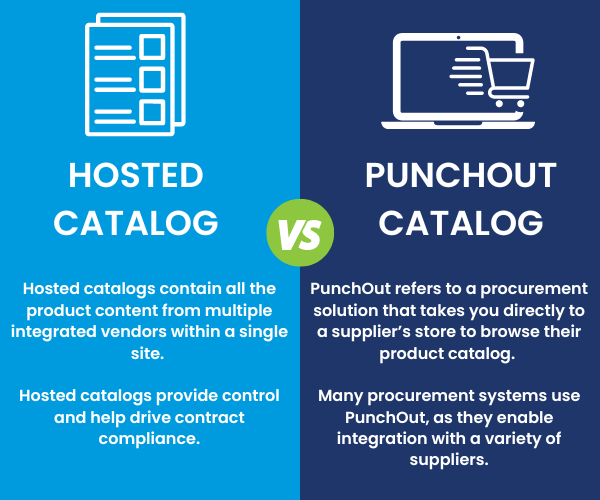Table of Contents
The demands of modern electronic procurement, especially in the post-pandemic world, are increasingly complex. Buyers are continuing to implement and adopt new technology, and there is more pressure than ever for suppliers to support digital channels.
A large part of meeting a buyer’s request in today’s procurement space means deciding between PunchOut catalogs or hosted catalogs. Depending on the business needs, there are pros and cons to offering each product catalog type.
Knowing whether to offer a PunchOut catalog or hosted catalog can give your business the competitive advantage to grow revenue through your eCommerce store and strengthen the relationship between trading partners.
What Are Hosted Catalogs?
A Hosted Catalog is a static product file (often in CSV, XML, or CIF format) uploaded into the buyer’s eProcurement system, it is also referred to as an e-catalog or static catalog. Hosted catalogs offers basic information about product names, descriptions and prices. This static file is uploaded and stored in the customer’s procurement system.
Important considerations for hosted catalogs are:
- While the static nature of hosted catalogs is efficient for small lists with limited inventory, there are significant limitations for larger product lists – especially ones that contain hundreds or thousands of products.
- Hosted catalogs offer no real-time information on stock levels, back-up inventory or availability status on the supplier’s website.
- Search requests often lack efficiency and/or accuracy in finding specific products, often forcing customers to manually look up prices and other data through external searches which can be time-consuming.
- Hosted files are typically outdated the minute they’re uploaded as products and pricing change, the file doesn’t.
Despite the limitations of hosted catalogs, they still serve a purpose in digital purchasing for industry-specific scenarios. However, it’s important to understand how other types of catalogs, like PunchOut catalogs, can be useful and provide more efficiency for buyer and supplier users.
What Are PunchOut Catalogs?
A PunchOut Catalog is an integration that connects a buyer’s eProcurement system (e.g., Coupa, SAP Ariba, JAGGAER) directly to a supplier’s eCommerce site. PunchOut catalogs, enables real-time product, pricing and availability information to buyers. PunchOut technology integrates procurement systems directly with a supplier’s eCommerce website, allowing a contact at a buyer company to search and browse an interface that is customized with their negotiated pricing.
A PunchOut catalog also has its own considerations in the eProcurement space, including:
- The ability to save time by offering real-time updates such as price, stock levels and other critical data that customers need to know for their purchases. Rather than having a static product list that must be manually uploaded into procurement systems, updates happen directly on the supplier’s websites, giving both parties more control throughout the buying process.
- Some PunchOut systems offer additional technical documentation, such as delivery notes and invoices.
- Leveraging a supplier’s site for PunchOut allows them to offer search and browsing experience suitable to their products as well as the ability to save personal lists of frequently ordered products.
Need a PunchOut Solution?
How to Choose Between Hosted or PunchOut Catalogs

Whether you are a buyer or a supplier looking to improve your purchasing processes, both hosted catalogs and PunchOut catalogs have benefits. But how do companies decide which is the best fit?
Here are some helpful questions to consider:
- Is it important to have real-time access to any changes to products or pricing?
- How impactful is controlling a specific category of spend to my organization?
- Do you need to provide special offers as well as special quotes and processes?
PunchOut vs Hosted Catalog: Feature Comparison
| Feature | PunchOut Catalog | Hosted Catalog |
|---|---|---|
| Data Source | Live eCommerce site | Static file in buyer’s system |
| Pricing | Real-time, buyer-specific | Pre-set, updated manually |
| Inventory Updates | Instant, live feed | Only when file is refreshed |
| User Experience | Supplier’s branded site | Buyer’s procurement portal UI |
| Configuration Support | Yes | Limited or none |
| Setup Time | Moderate (requires integration) | Quick (file upload) |
| Maintenance | Automated via eCommerce | Manual file updates |
| Best For | Large, complex, or frequently updated catalogs | Small, stable catalogs |
So, When to Choose Each?
- Choose PunchOut if
- You have frequent price or inventory changes.
- Products are configurable or customized.
- You want to offer a branded, familiar eCommerce shopping experience.
- Buyer-specific terms and pricing are common.
- Choose Hosted if:
- Your catalog rarely changes.
- Buyers prefer working entirely in their eProcurement system.
- You have limited technical resources for integration.
Yes, static catalogs may seem easier for the customer to use, but they require some level of maintenance on the buyer side. After the supplier initially uploads the catalog to the buyer’s procurement system, the buyer has to take on admin rights to accept, approve and publish the catalog to their users. In some cases, there are even checks and balances put in to validate pricing and price deltas before a catalog can be made visible to all users at a buyer’s company.
PunchOut catalogs are often seen as the modern option for B2B companies – making the overall shopping process more seamless and less taxing on the buyer as the maintenance falls on the supplier.
Although both types of catalogs offer more control for buyers, hosted catalogs are more of a challenge for vendors to keep updated with critical product information. It’s also often more difficult for buyers to search.
Important Considerations for Your Business
What Suppliers Should Consider
As the procurement space continues to evolve and customers search more online, it can be difficult to know whether a Hosted Catalogs or PunchOut catalog is the best fit right one for your procurement system, especially if you plan to scale your eProcurement process.
In a rapidly revolving space such as digital commerce, suppliers often must evaluate which catalog route will best serve their needs both today and tomorrow.
Will what works today still be the best solution a year from now? Is it best to modernize to a PunchOut system or maintain a large static catalog?
The cost and complexity of PunchOut may seem daunting, but in the end, maintaining one eCommerce site is easier than trying to control hundreds of individual static catalogs.
What Buyers Should Consider
When you need to make a purchase, it’s critical to know that the price points and inventory are up-to-date. Especially for buyers with high volume of direct spend, getting the right inventory is critical.
Despite its necessity, the buying process can be manual, tedious and require significant administrative work. That’s why many buyers prefer to purchase from suppliers who are able to support buying that can be done directly within the procurement system.
Rather than taking a shot in the dark and hoping for the best, partnering with vendors who offer supplier hosted catalogs (PunchOut) can make the difference between on-time and unavailable.
PunchOut Catalogs Are the Future of B2B Transactions
PunchOut catalogs are a better fit for the purchasing process – especially if you sell or need to buy complex service-oriented products.
Additionally, if you have large catalogs with thousands of SKUs and line items or customized items; products that require regular updates on price, description, and availability; or have a high number of transactions, a PunchOut catalog is the best route.
PunchOut catalogs are the future of transactions between an eProcurement system and eCommerce system.
Ready to launch a seamless PunchOut experience?
Hosted Catalog vs PunchOut Catalog – FAQs
A Hosted Catalog is a static file of product data stored in the buyer’s eProcurement system. A PunchOut Catalog is hosted on the supplier’s eCommerce site and integrates in real time, offering live pricing, availability, and a branded shopping experience.
A supplier-hosted catalog is another term for a PunchOut Catalog. All product information, pricing, and inventory are maintained on the supplier’s eCommerce platform, ensuring buyers see real-time updates and customized content based on their contract terms.
Hosted Catalogs work well for small, stable product lists that change infrequently. PunchOut Catalogs are best for large or complex inventories, configurable products, and organizations seeking real-time updates and buyer-specific pricing.
Yes. Many organizations use Hosted Catalogs for frequently purchased, standard items and PunchOut Catalogs for specialized or configurable products that require live data.




